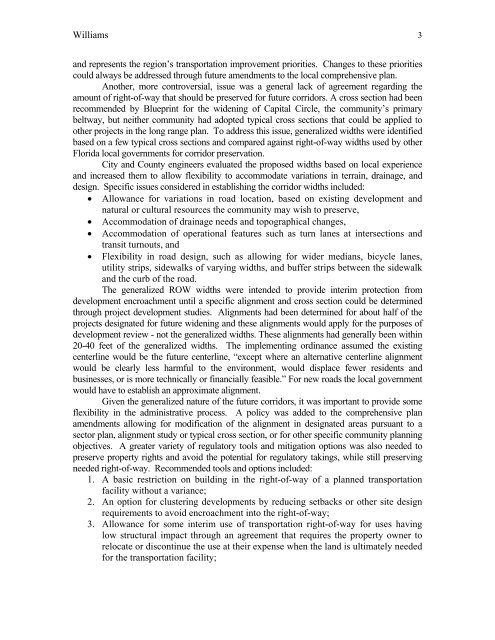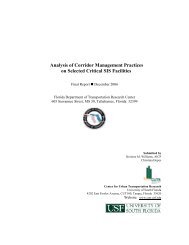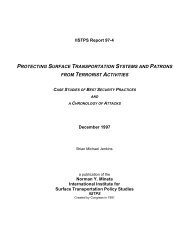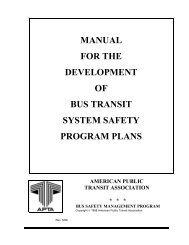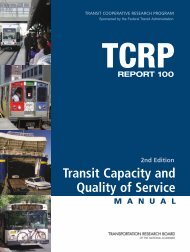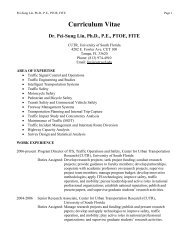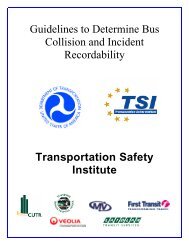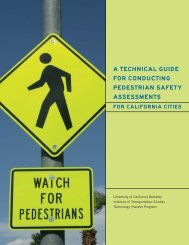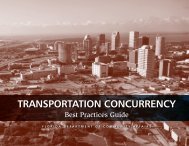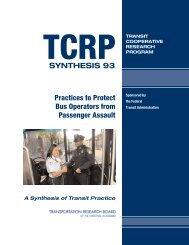Tallahassee-Leon County Corridor Management Program
Tallahassee-Leon County Corridor Management Program
Tallahassee-Leon County Corridor Management Program
Create successful ePaper yourself
Turn your PDF publications into a flip-book with our unique Google optimized e-Paper software.
Williams 3and represents the region’s transportation improvement priorities. Changes to these prioritiescould always be addressed through future amendments to the local comprehensive plan.Another, more controversial, issue was a general lack of agreement regarding theamount of right-of-way that should be preserved for future corridors. A cross section had beenrecommended by Blueprint for the widening of Capital Circle, the community’s primarybeltway, but neither community had adopted typical cross sections that could be applied toother projects in the long range plan. To address this issue, generalized widths were identifiedbased on a few typical cross sections and compared against right-of-way widths used by otherFlorida local governments for corridor preservation.City and <strong>County</strong> engineers evaluated the proposed widths based on local experienceand increased them to allow flexibility to accommodate variations in terrain, drainage, anddesign. Specific issues considered in establishing the corridor widths included:• Allowance for variations in road location, based on existing development andnatural or cultural resources the community may wish to preserve,• Accommodation of drainage needs and topographical changes,• Accommodation of operational features such as turn lanes at intersections andtransit turnouts, and• Flexibility in road design, such as allowing for wider medians, bicycle lanes,utility strips, sidewalks of varying widths, and buffer strips between the sidewalkand the curb of the road.The generalized ROW widths were intended to provide interim protection fromdevelopment encroachment until a specific alignment and cross section could be determinedthrough project development studies. Alignments had been determined for about half of theprojects designated for future widening and these alignments would apply for the purposes ofdevelopment review - not the generalized widths. These alignments had generally been within20-40 feet of the generalized widths. The implementing ordinance assumed the existingcenterline would be the future centerline, “except where an alternative centerline alignmentwould be clearly less harmful to the environment, would displace fewer residents andbusinesses, or is more technically or financially feasible.” For new roads the local governmentwould have to establish an approximate alignment.Given the generalized nature of the future corridors, it was important to provide someflexibility in the administrative process. A policy was added to the comprehensive planamendments allowing for modification of the alignment in designated areas pursuant to asector plan, alignment study or typical cross section, or for other specific community planningobjectives. A greater variety of regulatory tools and mitigation options was also needed topreserve property rights and avoid the potential for regulatory takings, while still preservingneeded right-of-way. Recommended tools and options included:1. A basic restriction on building in the right-of-way of a planned transportationfacility without a variance;2. An option for clustering developments by reducing setbacks or other site designrequirements to avoid encroachment into the right-of-way;3. Allowance for some interim use of transportation right-of-way for uses havinglow structural impact through an agreement that requires the property owner torelocate or discontinue the use at their expense when the land is ultimately neededfor the transportation facility;


